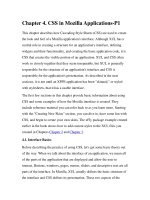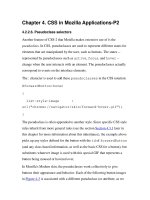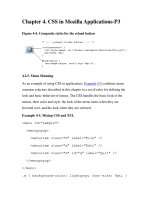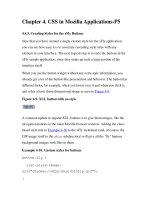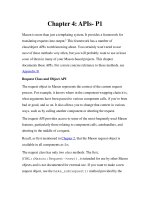Circuit design with HDL Chapter 4 Structural modeling pdf
Bạn đang xem bản rút gọn của tài liệu. Xem và tải ngay bản đầy đủ của tài liệu tại đây (2.7 MB, 51 trang )
CHAPTER 4: STRUCTURAL MODELING
Lecturer: Ho Ngoc Diem
1
NATIONAL UNIVERSITY OF HO CHI MINH CITY
UNIVERSITY OF INFORMATION TECHNOLOGY
FACULTY OF COMPUTER ENGINEERING
Agenda
Chapter 1: Introduction
Chapter 2: Modules and hierarchical structure
Chapter 3: Fundamental concepts
Chapter 4: Structural modeling (Gate & Switch-level modeling)
Chapter 5: Dataflow modeling (Expression)
Chapter 6: Behavioral modeling
Chapter 7: Tasks and Functions
Chapter 8: State machines
Chapter 9: Testbench and verification
Chapter 10: VHDL introduction
2
Content
Chapter 4:
A – Overview
What is structural modeling
Primitive gates
Switches
User-defined primitives
B – Examples
Combinational Circuit
Sequential Circuit
3
A – Overview
Primitive Gates, Switches, User-defined primitives
4
Verilog model for hardware design
5
Verilog design
Gate/Switch level modeling Behavioral modeling Dataflow modeling
- Primitive switch, gate
- User defined primitive
-Continuous assignment
(assign)
- Expression (operators)
There are different ways of modeling a hardware design. Choose an
appropriate model to design Combinational or Sequential Circuit.
Some books do not classify Dataflow modeling as a separate modeling
type.
RTL Design
- Procedural assignment
- initial, always block
- Conditional statement…
Structural model
When Verilog was first developed (1984) most logic simulators
operated on netlists
Netlist: a list of gates and show how they are connected
together
A natural representation of a digital logic circuit
Not the most convenient approach to express the test benches
6
Structural model
Structural
- Explicit structure of the circuit
- How a module is composed as an interconnection of more primitive
modules or components
- E.g. Each logic gate initially instantiated and connected to others
In Verilog, a structural model consists of:
- List of connected components
- Like schematics, but using text: netlist
- Boring when write, and hard to decode
- Essential without integrated design tools
7
Structural model
Structural Models are built from gate primitives,
switches, and other modules
Describe the logic circuit using logic gates
8
12 primitive logic gates predefined in the Verilog HDL
Advantanges:
Gates provide a much closer one-to-one mapping
between the actual circuit and the model.
There is no continuous assignment equivalent to the
bidirectional transfer gate.
Primitive gates
9
And/Or/Nand/Nor/Xor/Xnor
One scalar output
Multiple scalar inputs
The first terminal in the list of
gate terminals is an output and
the other terminals are inputs
wire OUT, IN1, IN2; // basic gate instantiations.
and a1(OUT, IN1, IN2);
nand na1(OUT, IN1, IN2);
or or1(OUT, IN1, IN2);
nor nor1(OUT, IN1, IN2);
xor x1(OUT, IN1, IN2);
xnor nx1(OUT, IN1, IN2);
// More than two inputs; 3 input nand gate
nand na1_3inp(OUT, IN1, IN2, IN3);
// gate instantiation without instance name
and (OUT, IN1, IN2); // legal gate instantiation
Verilog automatically instantiates
the appropriate gate.
Terminal list
Primitive gates
10
Buf/Not Gates
One scalar input
One or more scalar outputs
The last terminal in the port list
is connected to the input
// basic gate instantiations.
buf b1(OUT1, IN);
not n1(OUT1, IN);
// More than two outputs
buf b1_2out(OUT1, OUT2, IN);
// gate instantiation without instance name
not (OUT1, IN); // legal gate instantiation
Primitive gates
11
Bufif/notif
Gates with an additional control signal on buf and not gates
bufif1 b1 (out, in, ctrl); bufif0 b0 (out, in, ctrl); notif1 n1 (out, in, ctrl); notif0 n0 (out, in, ctrl);
Primitive gates
12
Propagate only if control signal is asserted.
Propagate z if their control signal is de-asserted
Array of Instances
wire [7:0] OUT, IN1, IN2;
nand n_gate[7:0](OUT, IN1, IN2);
// This is equivalent to the following 8 instantiations
nand n_gate0(OUT[0], IN1[0], IN2[0]);
nand n_gate1(OUT[1], IN1[1], IN2[1]);
nand n_gate2(OUT[2], IN1[2], IN2[2]);
nand n_gate3(OUT[3], IN1[3], IN2[3]);
nand n_gate4(OUT[4], IN1[4], IN2[4]);
nand n_gate5(OUT[5], IN1[5], IN2[5]);
nand n_gate6(OUT[6], IN1[6], IN2[6]);
nand n_gate7(OUT[7], IN1[7], IN2[7]);
The instances differ from each other only
by the index of the vector to which they
are connected
Primitive gates
13
Example: Gate-level multiplexer
4-to-1 Multiplexer
// Module 4-to-1 multiplexer.
// Port list is taken exactly from the I/Odiagram.
module mux4_to_1 (out, i0, i1, i2, i3, s1, s0);
// Port declarations from the I/O diagram
output out;
input i0, i1, i2, i3;
input s1, s0;
14
Primitive gates
Example: Gate-level multiplexer
// Internal wire declarations
wire s1n, s0n;
wire y0, y1, y2, y3;
// Gate instantiations
// Create s1n and s0n signals.
not (s1n, s1);
not (s0n, s0);
// 3-input and gates instantiated
and (y0, i0, s1n, s0n);
and (y1, i1, s1n, s0);
and (y2, i2, s1, s0n);
and (y3, i3, s1, s0);
// 4-input or gate instantiated
or (out, y0, y1, y2, y3);
endmodule
Logic Diagram for 4-to-1 Multiplexer
15
Primitive gates
Switches
16
There are two kinds of switch:
* MOS switches :
cmos, nmos, pmos, rcmos, rnmos, rpmos
* Bidirectional pass switches:
tran, rtran, tranif1, rtranif1, tranif0, rtranif0
Advantages:
- Gates provide a much closer one-to-one mapping between the
actual circuit and the model.
- There is no continuous assignment equivalent to the
bidirectional transfer gate.
MOS switches: nmos, pmos, rnoms, rpmos
Unidirectional channel for data, similar to bufif gate
CONTROL
when “off”
nmos
rnmos
nmos
when “on”
rnmos
when “on”
R
R
pmos
rpmos
pmos
when “on”
rpmos
when “on”
R
CONTROL
DATA
DATA
Ex: pmos p1 (out, data, control)
Ex: nmos n1 (out, data, control)
Switches
R
when “off”
17
MOS Switches: cmos, rcmos
R
R
cmos
when on
rcmos
when on
cmos (out, in, n_control, p_control)
in
out
p_control
n_control
Switches
when “off”
cmos
rcmos
18
Switches
tranif0, tranif1, rtranif0, rtranif1: block signal when turn off,
pass signal when turn on
tran, rtran: always pass signal
Terminals be scalar nets or bit-select of vector nets
Ex: tranif0 (inout1, inout2, control)
Ex: tran (inout1, inout2)
Bidirectional pass switches
19
20
R
R
tran rtran
R
R
tranif0 rtranif0
R
R
tranif1 rtranif1
tranif0 , rtranif0
tranif1, rtranif1
tran, rtran
inout1
inout2
inout1
inout2
inout1
inout2
control
control
Switches
Bidirectional pass switches
Switches
Ref “Verilog digital system design”, Zainalabedin Navabi for
design examples at switch level
21
Strength modeling
Allows specification of drive strength for primitive gate outputs
and nets.
Gate output or net signal strength values are specified in a set of
parenthesis that include a strength value for logic 0 and one for
logic 1.
Drive strengths for logic 0 (strength0):
supply0, strong0, pull0, weak0, highz0
Drive strengths for logic 1 (strength1):
supply1, strong1, pull1, weak1, highz1
Charge strengths, representing the strength of a capacitive net:
large, medium, small
22
Drive strength values of primitive gate outputs
Strength modeling
Ex:
23
Strength values of nets
Strength modeling
Strength0
Strength1
Drive strength
Charge strength
24
The stronger signal shall dominate all the
weaker drivers and determine the result.
Strength level
Strength modeling
25


